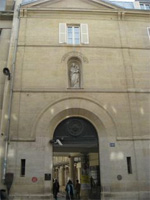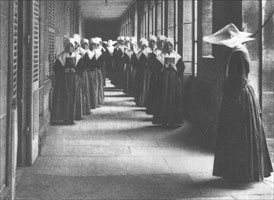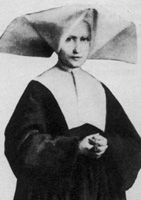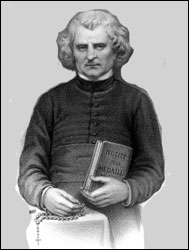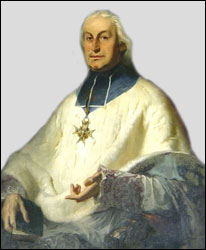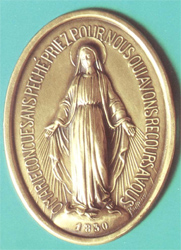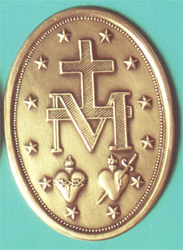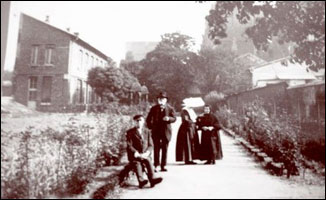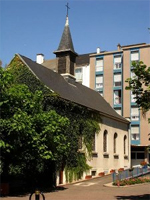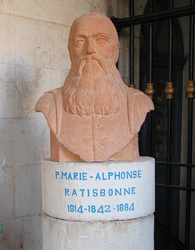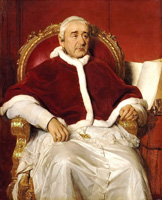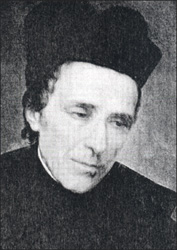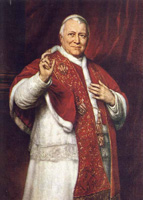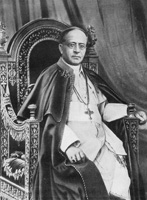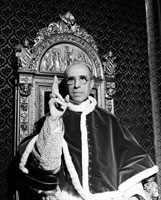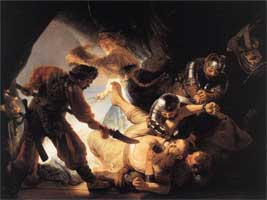IN JULY 1947, POPE PIUS XII CANONIZED A TOP SECRET "GAY" NUN NAMED CATHERINE LABOURE WHO CLAIMED THAT THE "IMMACULATE VIRGIN" APPEARED TO HER TWICE IN A CONVENT IN PARIS!! |
Canonization means that the soul has been released from the "Church Suffering" in "Purgatory" and has joined the "Church Triumphant" in heaven!
Zoé Labouré was born in the Burgundy region of France, on May 2, 1806. Her name was changed to Catherine when she became a nun in 1830. Zoé's parents, Pierre and Louise, never bothered to teach her to read or write so she was illiterate when she entered the convent in Paris. Ignorance is truly the mother of devotion.
24-year-old Zoé entered the novitiate or seminary at 140 rue du Bac in April 1830. If it wasn't for the horrible Saint Bartholomew's Day Massacre, no nunneries would exist in France. Saint Paul never told young women to enter a convent. He admonished them to get married and have children:
So I counsel younger women to marry, to have children, to manage their homes and to give the enemy no opportunity for slander. For some have already turned aside after Satan ( I Timothy 5:14-15, Greek Orthodox Version).
Her illiteracy was no problem as no entrance examination was required. The main requirements for a novice nun was total obedience to the Mother Superior and a strict conformity to the convent rules.
While the other novices enjoyed the fine French cuisine, Catherine shamed them by fasting on Fridays and Saturdays. That was the secret that enabled the Queen of Heaven to appear to her twice.
|
Absolutely nothing was mentioned of her stay during the 9 months novitiate except a brief entry stating that she was gay:
As it is, we can reconstruct nothing of those days, for we have no whisper of evidence to go on. Let it not be stated flatly, however, that Catherine would have no part in such doings. In the terse, two-sentence biography written in the seminary record book, her directress states that during her noviceship Catherine was, surprisingly enough, "gay." It is an adjective no one would have applied to her in her former life, except possibly in her early childhood. It is an adjective no one would apply to her again. (Dirvin, Saint Catherine Labouré of the Miraculous Meda, p. 108).
Catherine had her first vision on July 19, called the "Virgin of the Chair," because the "Immaculate Virgin" was sitting in a chair. That vision was preparatory to the "Miraculous Medal" vision that took place at the end of November of the same year.
|
Here is an account of that apparition by her official biographer, Joseph I. Dirvin, a priest and former professor at St. John's University in Brooklyn, New York:
The Virgin held in her hand a golden ball which she seemed to offer to God, for her eyes were raised heavenward. Suddenly, her hands were resplendent with rings set with precious stones that glittered and flashed in a brilliant cascade of light. So bright was the flood of glory cast upon the globe below that Catherine could no longer see Our Lady's feet.
Mary lowered her eyes and looked full at Sister Labouré. Her lips did not move but Catherine heard a voice.
"The ball which you see represents the whole world and France in particular."
Those words stirred the heart of the Sister with fresh transports of joy, and the dazzling rays seemed to her to increase to blinding brilliance (Dirvin, Saint Catherine Labouré of the Miraculous Medal, p. 93).
The "Immaculate Virgin" instructed Catherine to make a medal of the vision she had seen:
At that moment, Catherine was so lost in delight that she scarcely knew where she was, whether she lived or died. The golden ball vanished from Mary's hands, her arms swept wide in a gesture of motherly compassion, while from her jewelled fingers the rays of light streamed from the white globe at her feet. An oval frame formed around the Blessed Virgin, and written within in letters of gold Catherine could read the words:
"O Mary, conceived without sin, pray for us who have recourse to thee."
The voice spoke again: "Have a medal struck with this model. All who wear it will receive great graces, They should wear it around the neck. Graces will abound to persons who wear it with confidence." (Dirvin, Saint Catherine Labouré of the Miraculous Medal, p. 94).
Immediately after seeing the vision, Catherine told her confessor–a Vincentian priest named Jean Marie Aladel. Aladel was the confessor for all the novices and nuns so there were no secrets hid from him.
|
|
|
Catherine persisted however, and Jean Marie Aladel consulted his boss, the archbishop of Paris. The archbishop reminded Fr. Aladel that according to the Council of Trent he had the power to forgive the sins of Catherine, and that was why the "Immaculate Virgin" appeared to her.
The archbishop gave the go ahead for the minting of the medal, but insisted that strict secrecy be observed about her identity. Whether he had doubts or not was not revealed because he was removed from the scene of intrigue in 1839.
After getting the green light from Pope Gregory XVI, a goldsmith named Adrien Vachette began producing the medals by the thousands.
|
The original vision had the "Immaculate Virgin" holding a globe surmounted by a cross, but that globe was considered too overtly Catholic, and it did not appear on the "Miraculous Medal."
By 1836, goldsmith Adrien Vachette had sold over 2,000,000 medals, with the Sisters of Charity and the Vatican receiving a large share of the profits.
As devotion to the "Miraculous Medal" spread like wildfire throughout Europe and the world, images of the world in the shape of a GLOBE proliferated. Christians who upheld the Biblical cosmology didn't realize that they were really fighting a GLOBAL Catholic Inquisition.
The "global nun" was anonymous until her death in 1876!!
After her brief stay at 140 rue du Bac had ended, Catherine was sent to a hospice at Enghien–a suburb of Paris. That hospice took care of old people and French soldiers wounded in battle.
|
|
There was great rejoicing at the Enghien-Reuilly convent when Catherine finally died:
Her death brought no sadness to the house. Death is never sad in religious houses, but the death of Sister Catherine seemed to leave with her Sisters a spirit of positive joy. As they filled the refectory for supper, Sister Dufes rose to speak to them: "Now that Sister Catherine is dead" she began, "there is no more cause for silence." As she went on to read to them Catherine's own account of her visions. The Sisters listened with wonder and growing excitement, for, in spite of the guesses and suspicions of years, no one had known for sure that Sister Catherine was the Sister of the Medal. (Dirvin, Saint Catherine Labouré of the Miraculous Medal, pp. 224-225).
When she finally died on January 2, 1877, special permission was obtained from the French government to inter her in a vault under the convent chapel. That chapel still exists today and is called Chappelle des Filles de la Charité.
The first "Miraculous Medal" convert was a "Jew" named Alphonse Ratisbonne!!
From the time the medal was first minted, miracles multiplied. Nuns encouraged people to wear them around their necks to ward off evil and guarantee a happy death. Reports began to pour in from various parts of the world of miraculous healing brought about by the "Miraculous Medal."
In 1842, the spectacular conversion of a "Jew" was obtained by wearing the medal while on a visit to Rome.
|
|
|
In 1842, a 28-year-old French "Jew" named Alphonse Ratisbonne was visiting Rome when he was persuaded by a friend to wear the medal:
The year 1842 had scarcely begun when an event occurred which brought the Miraculous Medal to the notice of the world outside the Church and resulted in the official recognition of the Medal by Rome itself. The event was the Conversion of Alphonse Tobie Ratisbonne. Ratisbonne was a citizen of the world in every respect. Scion of an old and wealthy Jewish family of Strasbourg, he was a lawyer by education and banker by trade. At twenty-eight he was in the prime of life, good-looking, good-humored, a man of charm and countless friends. (Dirvin, Saint Catherine Labouré of the Miraculous Medal, p. 166).
We should not be surprised that a fake "Jew" was worshipping the Queen of Heaven, because real Jews were doing the same thing 600 years before the coming of the Messiah:
The children gather wood, the fathers kindle the fire, and the women knead dough, to make cakes for the Queen of Heaven; and they pour out drink offerings to other gods, that they may provoke me to anger (Jeremiah 7:18).
After his "conversion, " Ratisbonne became a Jesuit priest and moved to Jerusalem. He worked closely with the British Empire Jews in colonizing Palestine with fake "Jews" aka Turkish Khazars.
Only 4 other men knew the identity of the global nun!!
The implications that the " Immaculate Virgin" had appeared to a lesbian nun would have collapsed the pillars of the Vatican. Therefore, steps were taken to guard her identity zealously. Only 4 other men, besides Jean Marie Aladel and the archbishop of Paris, knew her identity.
|
|
As the "Miraculous Medal" began to proliferate around the world, momentum began to build for the promulgation of the Immaculate Conception Dogma. That Dogma was formally defined by Pope Pius IX in 1854.
|
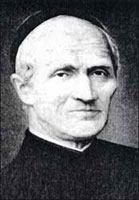 Peter Beckx SJ (1795–1887). Jesuit general from '53 to '87. |
Here is that Dogma as infallibly defined by Pope Pius IX:
We declare, pronounce and define that the doctrine which holds that the Blessed Virgin Mary, at the first instant of her conception, by a singular privilege and grace of the Omnipotent God, in virtue of the merits of Jesus Christ, the Saviour of mankind, was preserved immaculate from all stain of original sin, has been revealed by God, and therefore should firmly and constantly be believed by all the faithful. (Ineffabilis Deus, December 8, 1854).
Pope Pius XII canonized the lesbian nun in 1947!!
By 1931, the geopolitical climate was once again looking very bleak for the Vatican. The French Republic had survived the slaughter of World War I, and Russia was still a great world power. It looked like only a "miracle" could save the Papacy.
Pope Pius XI then made the momentous decision to give even greater prominence to the "Miraculous Medal" by canonizing Catherine Labouré. Beatification is the first step in that process.
|
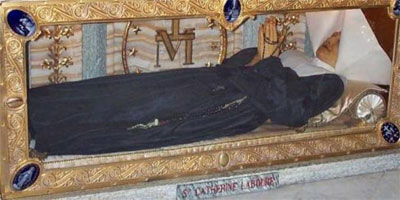 A Catherine Labouré look-alike now rests at 140 rue du Bac. |
Here is an account of that event by Joseph I. Dirvin:
The church now ordered the exhumation of the body of the saint. It had lain, sealed in the vault beneath the chapel at Reuilly, for fifty-seven years. The coffin was carried to the rue du Bac, and there opened in the presence of Cardinal Verdier, Archbishop of Paris, and a number of civil officials and doctors. As the lid was lifted, a gasp of astonishment went through the group. Catherine lay there, as fresh and serene as the day she was buried. Her skin had not darkened in the least; the eyes which had looked on Our Lady were as intensely blue as ever, and–most remarkable of all–her arms and legs were as supple as if she were merely asleep. (Dirvin, Saint Catherine Labouré of the Miraculous Medal, pp. 228-229).
After 57 years, all that was left of Catherine was a pile of bones....When the beatification was approved, a look-alike was quickly buried in the convent chapel. That corpse was disinterred and is now honored as the "Miraculous Medal" visionary. That was how the "miracle" of her bodily preservation came to pass.
With the defeat of his Axis powers in World War II, Pope Pius XII again desperately needed the help of the "Miraculous Medal." That was why the "sainthood" of Catherine was fast tracked.
|
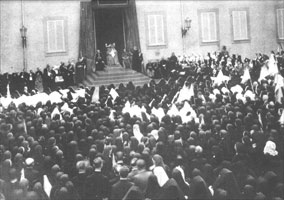 The canonization of Catherine by Pope Pius XII on July 27, 1947. |
The years immediately after the promulgation of the bodily Assumption of the "Immaculate Virgin" into heaven were very, very dangerous times for the world. Pope Pius XII was very good friends with Cardinal Spellman–the American Pope. Spellman was military vicar of the U.S. armed forces, and twice during the 1950's the world stood on the brink of nuclear war.
The "Miraculous Medal" has turned most Christians into blinded Samsons!!
There is a fascinating end of the world scenario found in the Old Covenant section of the Holy Bible. It is the story of Samson and Delilah. Samson was a mighty man and an army of one . . . who was invincible . . . until he met Delilah.
Thanks to the "space age" and the "Miraculous Medal," most Christians today believe that we live on a PLANET . . . instead of a PLANE.
|
The Jewish Messiah predicted this very situation:
Because you say, "I am rich, and have become wealthy, and have need of nothing,” and you do not know that you are wretched and miserable and poor and blind and naked (Revelation 3:17).
That was the very situation that ex-mighty man Samson found himself in after he was blinded and forced to work like an ox for the Philistines.
As his hair began to grow again, the blind, wretched, miserable Samson regained his strength, and brought down the temple of Dagon on the heads of the Philistines:
And Samson called unto JEHOVAH, and said, "O JEHOVAH Elohim, remember me, I pray thee, and strengthen me, I pray thee, only this once, O Elohim, that I may be at once avenged of the Philistines for my two eyes."
And Samson took hold of the two middle pillars upon which the house stood, and on which it was borne up, of the one with his right hand, and of the other with his left.
And Samson said, "Let me die with the Philistines." And he bowed himself with all his might; and the house fell upon the lords, and upon all the people that were therein. So the dead which he slew at his death were more than they which he slew in his life (Judges 16:29-30).
That is where the expression "bringing down the house originated."
The Jewish Messiah is our only Intercessor and Mediator. He is praying right now that all true Christians regain their spiritual sight and become Samsons for Christ.
Vital links
References
Aladel, Jean Marie, The Miraculous Medal: Its Origin, History, Circulation, Results. Kilner Publishers, Philadelphia, Penn, 1880.
Dirvin, Joseph I. C.M. Saint Catherine Labouré of the Miraculous Medal. Tan Books and Publishers, Inc., Rockford, Illinois, 1984. Originally published by Farrar, Straus & Cudahy, New York, 1958.
Copyright © 2016 by Patrick Scrivener
